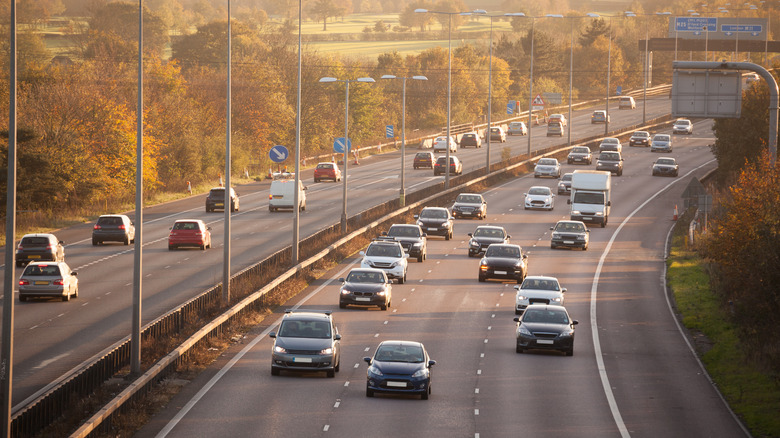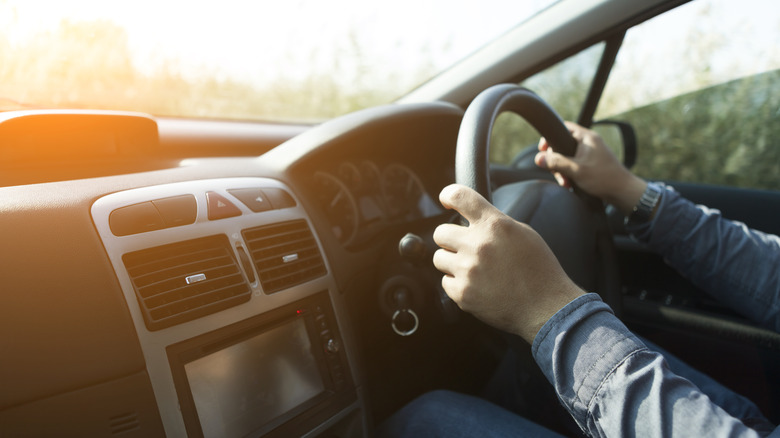How To Prepare Yourself For Driving On The Other Side Of The Road In The UK
The U.K. is one of 75 countries where driving is on the left-hand side of the road. Right-handed traffic, on the other hand (pun intended), is used in 165 countries. Most countries that adopted left-hand traffic used to be part of the British Empire. Some theories that attempt to explain this traffic difference allude to how horses were mounted, where pilgrims were directed, and which hand travelers held their swords back in the days of yore.
For anyone coming from those 165 countries, driving in the U.K. may be challenging, but with adequate preparation, you can quickly adapt. With a valid foreign driver's license, you can legally drive in the U.K. for up to a year. The minimum age to rent a car varies by company, typically 17 to 23 years, with extra fees often applied for drivers under 25.
Before hitting the road, learn the U.K. Highway Code to understand the specific rules and regulations. It includes details on road signs, markings, signals, and the rules for different types of roads. Ensure you understand this well to avoid any confusion and potential accidents. In the U.K., the driver's seat and controls are on the right side of the car. Spend some time familiarizing yourself with the layout of the vehicle you are renting before you hit the road. Practice until you're comfortable using your left hand for gear shifts, and note that the steering wheel is on the right.
Rules of the U.K. road
To the left, to the left ... the golden rule is to always keep to the left. Be especially vigilant about this when turning at intersections, entering roundabouts, or overtaking. Speaking of roundabouts, the traffic flows in a clockwise direction, which can be confusing for those used to the counter-clockwise way. Make sure to give way to vehicles coming from your right, not left, in a roundabout.
When approaching junctions and crossroads, stay calm, and remember to keep left and turn into the left lane unless otherwise indicated. You should also not forget to yield to traffic oncoming from your right. Perhaps before bracing busy junctions and roads, acclimate to driving on the left side by initially renting a car in a less congested area, somewhere rural and reachable by train. This can help build confidence by allowing you to adjust to a quieter setting before tackling big cities or congested highways.
Say you're driving down the A82 road in Scotland to see the mythical Loch Ness monster, but someone in front of you is cramping your style and driving just a little too slow. Overtaking in the U.K. is typically done on the right. Always ensure a clear view of the road ahead and check your mirrors before overtaking. Note that the speed limit is set at 70mph on highways and dual carriageways, 60mph on single carriageways, and 30mph in urban or residential areas. A speeding ticket is not a souvenir you want to bring home.
Simulations, slangs, and smooth transitions
Practicing on a driving simulator like Forza is a fun way to build confidence for your U.K. driving experience. You can also watch online videos showcasing left-sided driving. This can help you get more comfortable with left-side driving without the real-world risks. Also, if you're used to driving with automatic transmission back home, stick to automatic in the U.K. This would not be the right time to experiment with manual transmission.
Driving lingo is also slightly different in the U.K.; although the language is English, there is some unique car slang worth knowing. Highways are motorways, gas is petrol, transmission is gearbox, and a parking lot is a car park. Let's say something functionally happens to your "hire car" — you should probably hit the "handbrake," pull over "nearside" to a "hard-shoulder" or a "lay-by," open the "bonnet" of your "motor," and if it looks awry, call the A.A., also known as the British Automobile Association. Yes, that was all British English; be prepared to communicate some driving terms the U.K. way.
Transitioning from right-hand driving to left-hand driving can indeed be a challenge. However, you can efficiently adapt by understanding the rules, getting comfortable with a left-side vehicle, and sharpening essential driving skills. Confidence, developed over time and through gradual practice, plays a crucial role in this transition. Prepare yourself in advance, and driving on the other side of the road should be a breeze. You may even find yourself liking it more!


